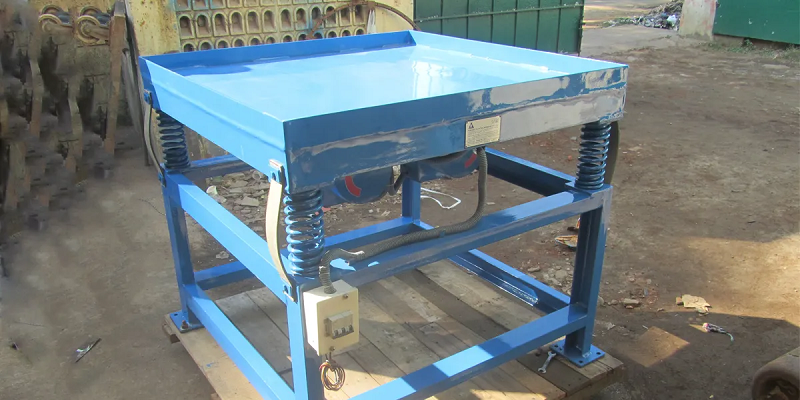In modern production and processing facilities, product integrity is the top priority. From automobile parts to packaged consumer goods, all products must undergo stringent quality checks to meet industry requirements. One of the many pieces of machinery that have stretched the ability and speed of such testing is the vibration table. These specialised vibration tables are now an absolute requirement to simulate actual operating conditions and check the endurance of products, packaging, and raw materials.
This article discusses how vibration tables enhance quality test procedures and their positioning within larger systems featuring equipment, such as Electromagnetic Separators, which guarantee purity and homogeneity of materials before and during testing.
The Role of Vibration Tables in Quality Assurance
A vibration table is a device that produces controlled vibrations across a range of frequencies and amplitudes. The produced vibrations mimic transportation, handling, and environmental stresses to which a product is exposed during its life. Quality engineers use such tables to expose weaknesses, faulty joints, or structural abnormalities in a controlled way, allowing for better product development before release.
One of the main applications of vibration tables is in package testing. Packages must be able to withstand the bumps and shocks of shipping logistics. A manufacturer can reproduce such conditions with a vibration table, locating points of failure that would spoil the contents during shipment.
Additionally, vibration testing guarantees that international safety and quality standards are achieved. This is particularly crucial in the automotive, aerospace, and pharmaceutical sectors. Failure in packaging or structural integrity could result in humongous financial and reputation loss.
Improving Material Testing with Vibration Tables
To test material behaviour, vibration tables are likewise frequently used to test powders, aggregates, or liquids subjected to repeated motion. This informs manufacturers how the material settles, separates, or compacts when stressed, critical data for food processing, construction, and pharmaceutical companies.
Besides, these compaction tables facilitate studies to determine the optimum vibration level required to minimise air voids and create uniform density. In concrete or ceramic manufacture, for example, this means increased strength and uniformity in end products.
Worth mentioning is the fact that vibration tables can be incorporated into lines of testing in automated testing, enhancing throughput and reducing the gap for human error. Their accuracy in mimicking on-field conditions places them in a mandatory position in a laboratory or production environment.
Synergy with Electromagnetic Separators
The accuracy of testing conducted on granular or particulate materials is mostly undermined by ferrous content contamination. This is where Electromagnetic Separators step in. By filtering out unwanted metal particles before or in combination with testing, these separators keep results pure and intact, quantifying actual material behaviour.
For instance, in pharmacy or food processing, trace amounts of iron particles in the product will result in aberrations in vibration test results and product recall. With the vibration table, Electromagnetic Separators offer material purity, thus allowing proper quality testing.
Equally, separators in recycling or refining raw materials remove metallic impurities that otherwise influence the performance of a product under vibratory stress. Integration of both tools facilitates smooth workflows, quality checks, and improved safety results.
Electro Flux Equipments: Ensuring Reliable Test Solutions
Electro Flux Equipments is well known for providing heavy-duty, high-speed machinery in various industries such as steel, cement, pharmaceutical, and food processing. Its high-quality vibration table products are very flexible and long-lasting, enabling manufacturers to optimise their testing process according to the specific operational conditions.
Their vibrating compacting tables provide optimum material compaction and product integrity testing, namely for concrete, chemical powders, and packaged goods. Their tables displace air pockets and voids, replicating actual vibrations in a highly accurate manner unmatched by others. Electro Flux also provides Electromagnetic Separators that can seamlessly be installed in lines for quality testing to eliminate even the smallest ferrous particles, assuring more consistent test results and improved final product quality.
Clients usually get non-consistent compaction tables, test contamination, or suboptimal test setups. Electro Flux eliminates these with quality ISO-certified equipment supplemented by fast turnaround service, a one-year warranty, and rugged construction. Their in-house engineering capability also enables them to offer custom configurations for demanding material handling and quality testing applications.
Conclusion
Accuracy and efficiency in testing for quality are no longer a matter of choice—both are the keys to successful production. Whether you are testing the durability of packages or verifying raw material cleanliness, equipment such as vibration tables and Electromagnetic Separators can be the difference-maker in your quality control system.
Electro Flux Equipments is a reliable partner in this regard, providing carefully engineered solutions with decades of experience and worldwide service reach. If you are looking for reliable, cutting-edge equipment to extend your testing potential, look into the variety of vibration tables and Electromagnetic Separators from Electro Flux Equipments today. Their tailored options and strong support system can assist you in creating a more efficient and reliable testing setting.


